-
American Goldfinch (1)
-
American Robin (1)
-
Baltimore Oriole (1)
-
Blue Jay (1)
-
Bluebirds (1)
-
Carolina Wren (1)
-
Chickadee (1)
-
Ducks (1)
-
Starling and House Sparrow (1)
-
House Finch (1)
-
House Wren (1)
-
Hummingbirds (5)
-
Northern Cardinal (1)
-
Northern Mockingbird (1)
-
Nuthatch (1)
-
Owls (3)
-
Tufted Titmouse (1)
-
Woodpeckers (6)
Choosing the Right Bluebird Nesting Box
Bluebirds are one of the most endeared and desired backyard neighbors. These birds are not only beautiful to look at, but they also have strong family values. Their family values are unparalleled in the bird world.
All of these things make them one of the most interesting species to watch and welcome into your neighborhood.
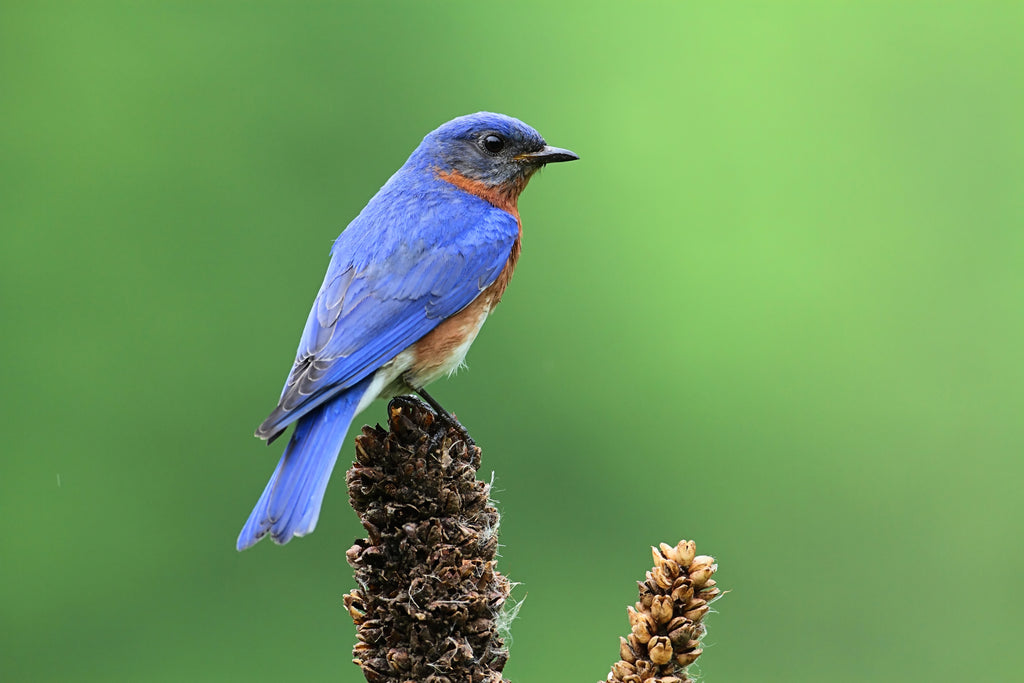
There are 3 species of bluebirds that inhabit the US. The Eastern, Western and Mountain Bluebirds.
The Eastern Bluebird is the most common to take up year-round residency. They are present in almost ⅔ of the US. With that in mind, most of the information we discuss here will center around the Eastern Bluebird.
Attracting these wonderful creatures to your backyard can sometimes be quick and simple. However, in some cases it can take years.
Simply having a bird house does not guarantee the presence of bluebirds. The "build it and they will come" scenario does not always work.
But on a positive note, once they do find a house they like, they are likely to return year after year. This is provided that the surrounding area remains the same and the house is well-maintained.
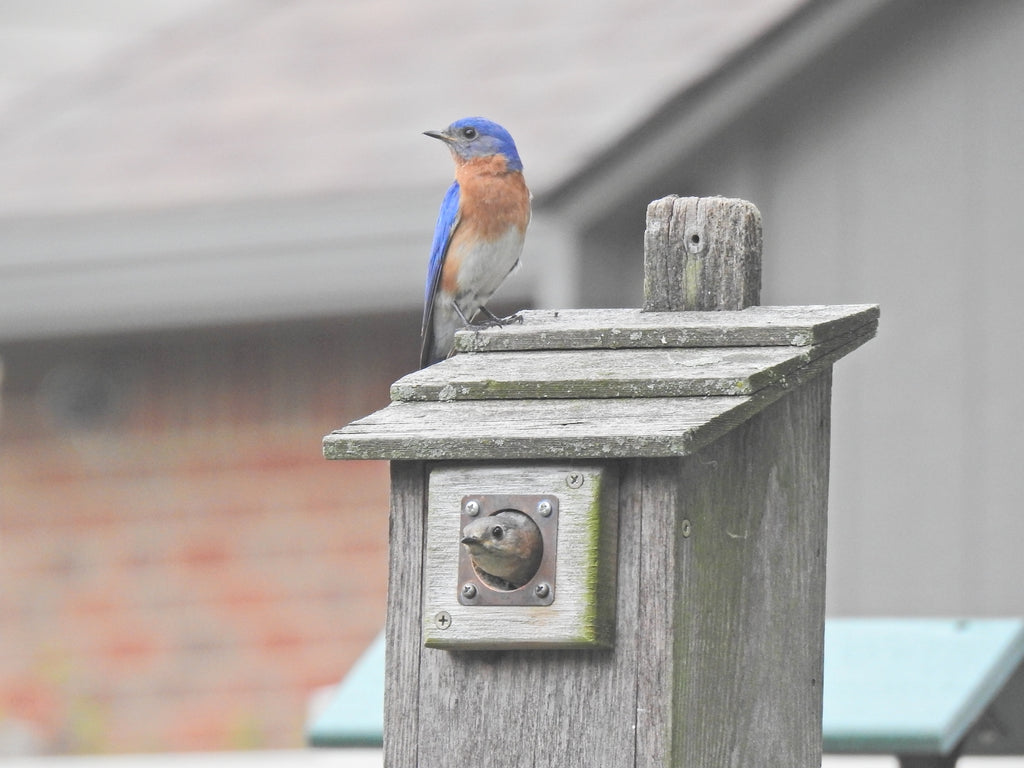
Let’s address a quick housekeeping item. A bird house, or birdhouse, can also be referred to as a nest box or nesting box. When those terms are used here, please treat them as the same thing - a house for a bird to build a nest in.
Bluebirds are cavity nesters. This means they will build their nest inside a cavity, or hole.
The American Robin for instance is not a cavity nester. Like the Northern Cardinal and many other birds, they will build a nest in a tree, in a shrub or even on a ledge.
Given that bluebirds are cavity nesters, offering them a birdhouse where they can construct a nest is a good first step in enticing them to hang out with you in the backyard.
We will address five different topics when talking about successfully attracting bluebirds to take up residence in your backyard.
- Types of bluebird houses and their characteristics
- Mounting or placing your house
- Bluebirds 101
- Predators
- Human neighbor responsibilities
Types of Bluebird Houses and Their Characteristics
There are many different types of bluebird nesting boxes out there on the market. For our purposes here, we are going to address the “basic house” and one other offshoot which we find very intriguing.
No matter what type of house you choose, there are a few basic essentials to keep in mind.
First of all, dimensions. The typical bluebird house is 4” to 5” square on the bottom. This provides an ideal space for the nest to be built.
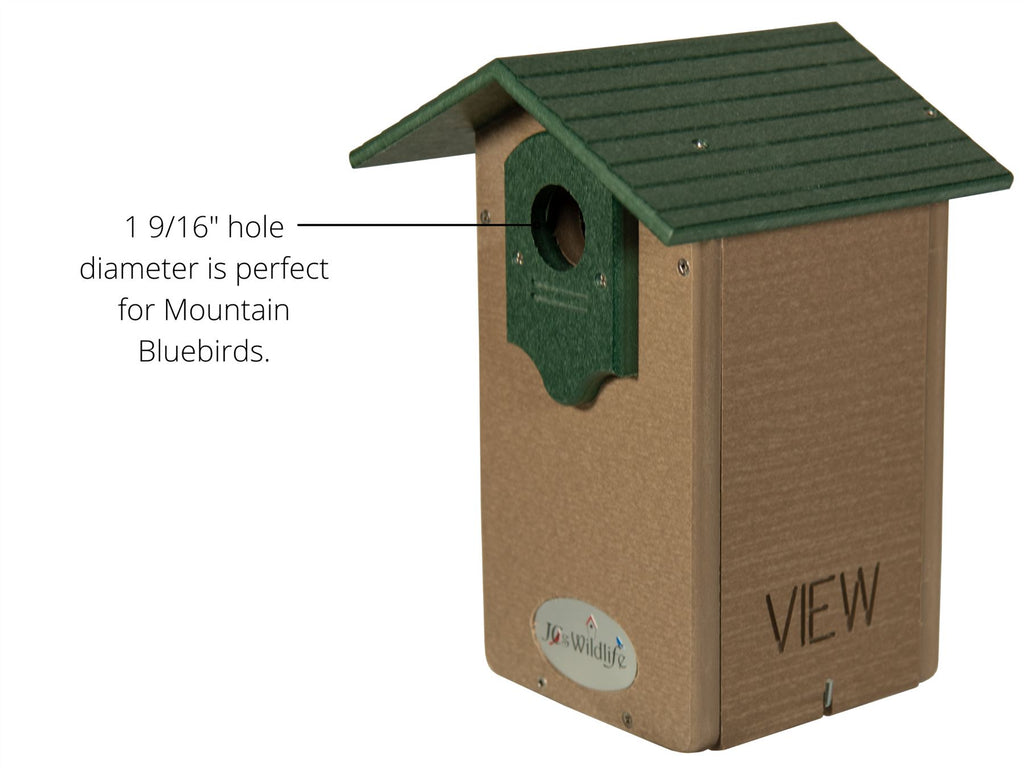
The base should be about 5” to 6” below the hole. This allows ample room for the birds to get in and out and enough distance between the hole and the nest to prevent predators from reaching the eggs or young.
The entry hole should be 1-½” in diameter for the Eastern & Western Bluebirds, 1-9/16” for the Mountain Bluebird. If the hole is any smaller, the bluebirds will not be able to go in and out. If it were any bigger, larger “bully birds” or predators would have easier access.
The basic bluebird house is often referred to as a NABS house. NABS stands for North American Bluebird Society.

These houses will closely adhere to the guidelines mentioned above and are considered to be the standard in nesting boxes.
They can be made from different materials, but rough, untreated wood is common. Cedar is probably the most used type of wood, along with exterior grade plywood.
Cedar weathers very well without any type of sealers or paint. It resists cracking, splitting and warping. It is also a natural insect repellent and is simply an attractive wood to look at.
It is very important not to use treated wood for bluebird houses. Something very plain and natural is desired. If you do wish to protect your bluebird house, a natural option like linseed oil is recommended.
Some people like to paint their wooden bluebird houses. While this is okay, you should never paint the inside, only the outside.
Another common material used for constructing bluebird houses is poly lumber. Poly lumber, or “poly”, is a man-made recycled plastic product.
Poly is environmentally friendly, as it is made from recycled materials like milk jugs and other discarded plastic containers. It is completely safe for birds and provides a safe, secure and durable place for bluebirds to nest.
Poly is very easy to clean, it doesn’t stain and it will last forever. You will pay a bit more for a house made of poly, and these houses will be heavier than the cedar wood versions. But when you consider the lifespan of the house and the other benefits of the poly material, it becomes a very economical and smart choice.
Other things to look for are proper ventilation openings and drainage.
It is very important for the birds to have good air circulation inside the house. Most houses will have gaps at the top under the roof to allow for proper air flow.
You should also check for drain holes in the bottom of the box. If water gets inside during a storm or heavy rain, it needs somewhere to drain. This ensures the nest will stay dry.
Perches are a no-no. A good bluebird house will have no perches.
Bluebirds don’t need to perch. They will fly right in and out of the entry hole with no problem. Perches would also provide a place for unwanted birds to hang out and access the box.
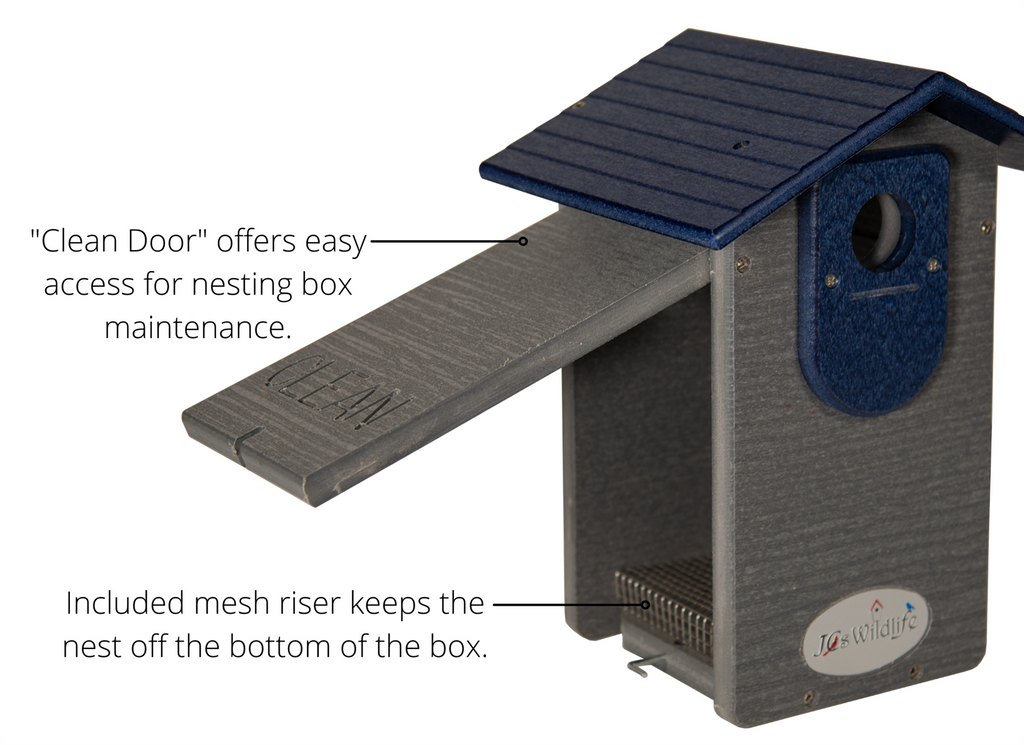
Another must-have is a clean out access.
Most houses will have a hinged front or side that can be opened to allow access for cleaning. For some of the lesser-valued houses, you may have to remove a panel by removing screws.
The bottom line is there needs to be a way of accessing the interior of the house for clean-out purposes. Houses that are desirable use stainless steel or galvanized screws. These screws won't rust in the elements.
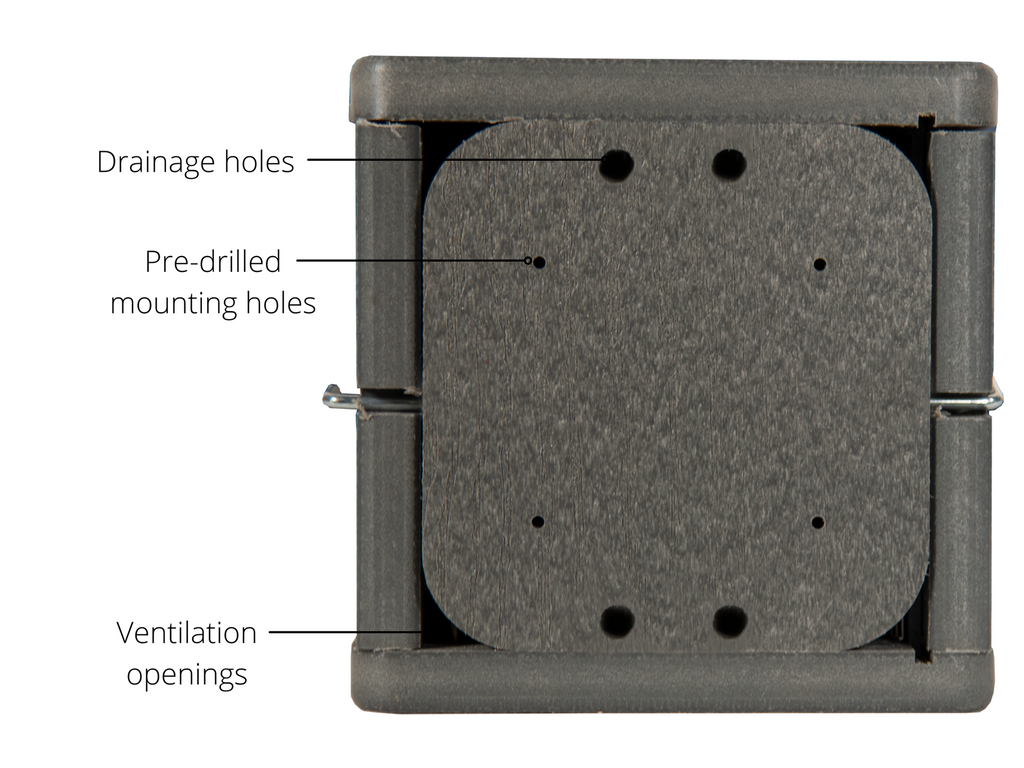
We can’t talk about bluebird nest boxes without mentioning the available options, or “add-ons”, if you will. While none of these are a necessity, they can help the bluebirds and the human “looky-loos”.
Here is a list:
- Predator Guard - I would personally view this one as more of a necessity than an option. A predator guard is an “extension” that is placed around the entry hole and sticks out about ½” to ¾” from the hole. Just like the name suggests, a predator guard is used to deter unwanted visitors who may want to make bluebird eggs or young their next meal. The predator guard lengthens the distance between the entry hole and the nest inside the box. They work great for varmints such as raccoons or squirrels.
- Kerfs - These are simply grooves cut into the wood or poly on the inside of the nest box, directly underneath the entry hole. The kerfs provide a gripping surface for the birds when they exit the nest.
- Floor Riser - A floor riser is typically a wire stand that sits in the bottom of the birdhouse. The nest is built on top of this riser, leaving a space between the bottom of the nest and the box bottom. This helps with both air circulation and drainage. It makes the inside of the house more healthy for the birds.
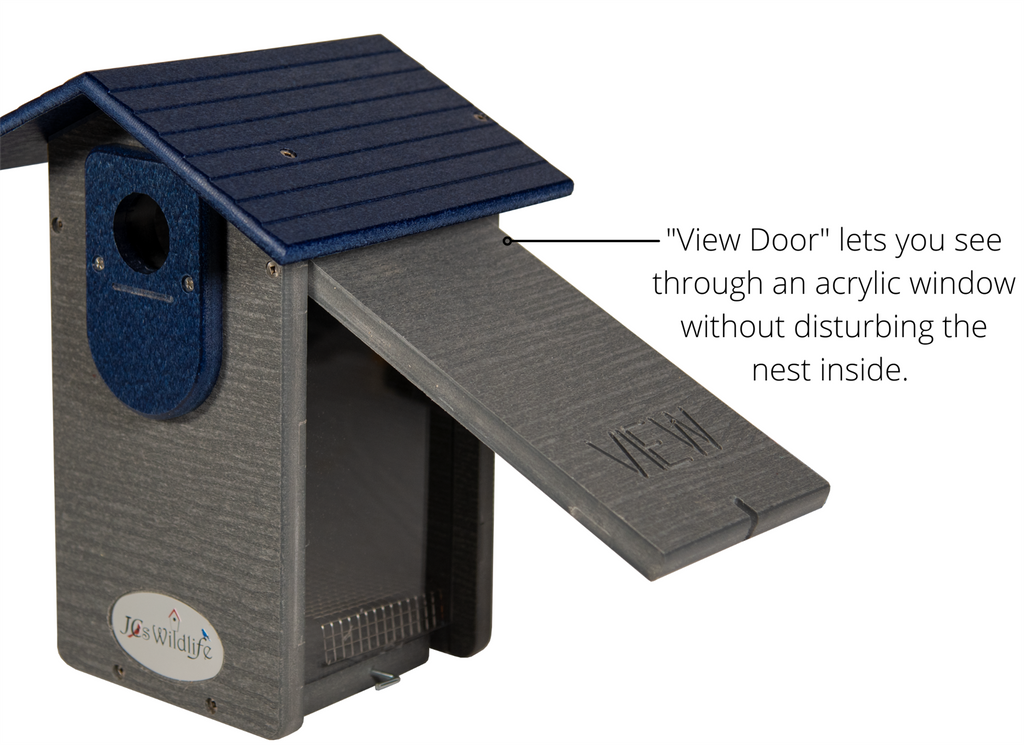
- View Door - Here’s a people-friendly option. We talked earlier about the clean-out door. The view door would be a similar hinged door that when opened, allows you to view the nest through a plexiglass window. Some bluebird boxes are made so that both sides will hinge open. One side is the clean-out, while the other side is for safe viewing.
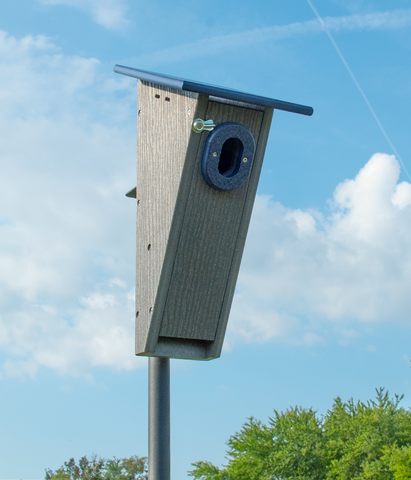
We want to look at one more specialized option before moving on to discuss the placement of your bluebird house. That is the Peterson Bluebird House.
The Peterson nest box was developed by Dick Peterson of Brooklyn, MN. His somewhat unique design has been modified over the years and has become increasingly popular.
Think of a cheese wedge turned bluebird house! A large downward-swinging front door allows easy access to clean or monitor the box.
This design also allows for the door to be open without disturbing the nest. The tilted nest shelf creates an ideal base on which the adult birds can construct their nest. It also has holes drilled in it to help with drainage.
The box has several openings. The bottom has a large slot opening. The sides have small openings. The roof and sides have front and rear gaps to promote airflow.
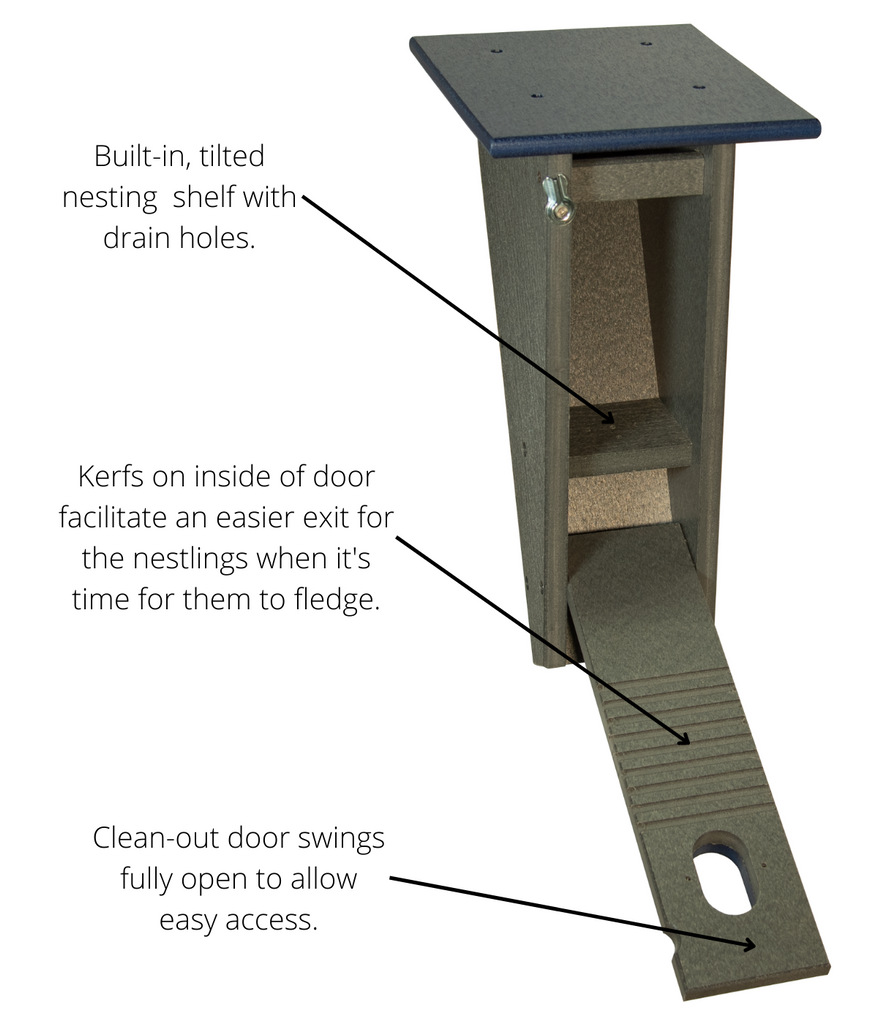
It is truly a unique design that merits some consideration when deciding on which bluebird house is best for your backyard.
Mounting and Placing Your Birdhouse
There are a few established rules when it comes to where you put your bluebird house and how you mount it.
As with most things in nature, the birds don’t always strictly adhere to these rules. Use these guidelines as a guide. However, don't let them stop you from using other methods you think would be best for your yard.
Most people mount a bluebird house on a tree or pole.
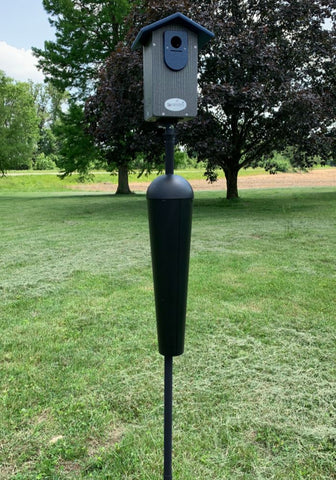
Fence posts should be avoided, as this gives predators and bully birds easier access. As a rule of thumb, mounting your house on a pole is ideal.
A tree can potentially restrict entry into the house with limbs and branches. It can also allow predators easier access.
The house should be mounted such that the entrance to the house is about 5’ off the ground. There should be a clear entry path into the house.
The front of the house should be positioned away from the prevailing winds. In most cases, the hole should face east or slightly northeast. This is because bluebirds nest in the spring and early summer. If possible, try to place the nest box away from wooded areas.
Many golf courses have bluebird houses placed in wide, open areas near the fairway tees. This provides an unobstructed entryway for the birds, with plenty of water and trees in the vicinity. This type of scenario could be difficult to achieve in a typical backyard. However, it gives you an idea of what is ideal for the bluebird.
Anything you can do to facilitate this type of situation in your own backyard will help attract these birds.
Mounting your bluebird box on a pole is the best option for several reasons. A pole can be mobile, unlike a tree. A pole can be more easily placed in an open area. Plus this provides much better protection from predators, especially when a baffle is used.
Bluebirds 101
Here are a few quick facts about bluebirds. These may help in deciding on a house and where to put it in your yard.
- The house-hunting activities can begin as early as February for bluebirds.
- Nesting season starts in late March or early April and continues into early summer.
- Bluebird couples will raise 2-3 broods per season; perhaps more if weather allows.
- Male bluebirds scope out house locations and “present” their findings to the female.
- Female bluebirds make the ultimate decision on a preferred nesting site.
- Males & females build the nest out of pine needles and grass - and it’s a very neat nest!
- Females will incubate 4-5 light blue colored eggs for about 2 weeks.
- Nestlings will remain in the house for an additional 17-21 days.
- Only the female incubates the eggs while the male guards the nest and his family.
- Feeding the young is shared between the male and female.
Bluebirds Adversaries and Predators
We have said this many times, “It stinks to be a bluebird!”
These awesome, beautiful birds just want to have their place in the world, but so many things are stacked against them! It is important to keep these bluebird enemies in mind when you choose a house and its location in your yard.
Let’s run through a few of the more common threats a typical bluebird family may face during nesting season.
- There are other birds out there who are also cavity nesters and will use the same kind of house for their nest as does a bluebird. Tree swallows and house wrens are 2 of our native species that compete with bluebirds for territory. Sometimes offering a second birdhouse away from the bluebird house will work to keep them in their lanes. However, the 2 most prolific opponents are the House Sparrow (also known as an English Sparrow or Spatzie) and the European Starling. Neither of these species is native to the US. The Starling is a “bully bird” that wants to take over feeders and housing. But the House Sparrow has been known to relentlessly attack and try to take over the bluebird nesting location, up to the point of destroying eggs and kicking out nestling birds. There are products available on the market to discourage them from setting sights on your nesting box.
- Enter the varmints - raccoons, squirrels and snakes. All of these critters have been known to eat bird eggs. Remember the predator guard discussion earlier? Using a pole to mount your bluebird house goes a long way in discouraging these guys. Also adding a baffle to the pole to deter anything that may want to climb up is a proactive approach to deter these predators.
- Think of those warm spring days when you are outdoors trying to enjoy some much-needed sunshine but those pesky gnats keep ruining your fun. They can be major pests with birds as well. In extreme cases, gnat swarms have been known to get inside the bluebird box and suffocate the young. There are natural deterrents that can be used on the outside of bluebird boxes to help with this.
- Lastly, at times simply the heat can cause issues for the babies in the nest. If the parents decide to produce a brood late in the season, this is where heat can be a concern. Earlier we talked about proper air ventilation for your nest box. This is where that comes into play in a big way.
Understand that welcoming bluebirds into your backyard comes with some responsibility. After all, you’re their landlord, right? Remembering these key points will help both you and your blue feathered friends maintain a great relationship.
- Choose the right bluebird house that checks all or most of the boxes for what we have discussed here.
- Try to place the house in a location that is both comfortable for the birds and allows you to monitor it.
- Recognize would-be intruders and take steps to offer the bluebirds some protection.
- Ensure the nesting box is well maintained. Who wants to live in a broken down house? It should be stable and sturdy. The ventilation and drainage areas should be free of debris and working properly. Old nests should be cleaned out and discarded after each set of babies have fledged and you have ensured the box is 100% vacant.
- Since bluebirds exclusively feed insects to their young, try to have some native plants in your yard that attract these bugs. Try to avoid pesticides if at all possible. Planting native will attract native bugs that will feed your birds!
- Having a water feature nearby, like a well-maintained birdbath, will also help your birds. Birds, just like us humans, need water to survive.
Attracting bluebirds to your backyard can be a fun experience. Setting up a nest box makes it educational for the whole family.
Bluebirds are beautiful creatures. Getting to see them on a regular basis while they go about raising their own family can be a true joy.
JCs Wildlife offers a variety of products to help you attract birds to your yard. These products include bluebird houses, pole systems, baffles, mealworm feeders and birdbaths. Visit our website at www.jcswildlife.com to check out options.
And above all, have fun with your outdoor backyard experience!
No comments
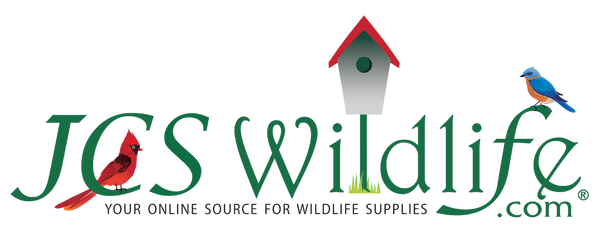
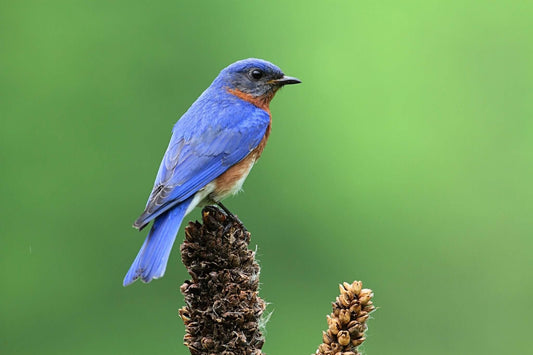


0 comments